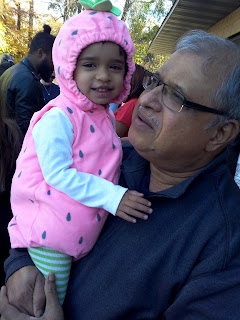Joint families had their advantages and disadvantages. Many persons belonging to three or four generations living under one roof was possible and necessary in the days of limited opportunities to move away and make a living. There were strong men working in the fields or outdoor jobs and women looking after maintaining food supply at home. There were relatively idle older people to look after the babies and toddlers. The system itself took care of the old and sick. Nobody was left alone to fend for himself or herself and old age was not a burden to be carried on one's own shoulders. True, physical pain and suffering was not transferable, but emotional and psychological support was always available to the older ones at home. The comfort level for the old and sick might not have been the same for all; it depended on the atmosphere and values at their respective homes. Nevertheless, there were no huge problems of the old living a life in solitary sojourns and waiting for the final call. There were indeed some cases here and there; it had not reached epidemic proportions. Medical facilities were limited and life expectancy was low as well.
Improved quality of life and developments in medical and surgical facilities have now enhanced the life expectancy. Education levels of women have noticeably gone up opening up abundant avenues for them to work and earn on the same footing as men. Advancement in transportation has enabled movement to far off lands for education and employment. Joint families have disintegrated and problems have crept up in taking care of infants and toddlers on one side and old and sick on the other. Better financial status of families can provide some funds for taking care of these sections. More and more "Daycare" facilities have come up for taking care of babies and toddlers and kids after they return from schools. The problem of managing old age and related issues has not yet found similar solutions around us at least for the present times.
There are some organizations that are doing yeoman service in taking care of the aged and sick. Some institutions provide good "Day care" facilities for the aged as well. Old age homes are growing in numbers and some of them are indeed providing good care and security to the inmates. Cost for quality care is naturally higher and all cannot afford these charges. Old age homes with lower charges are unable to provide quality care. Some of them present a pathetic look and a visit to them makes one sorrowful and sorry. The faces of the inmates has only one expression; the one of awaiting the final call. There is an urgent need to develop institutions that adopt a commercial yet compassionate approach to running old age homes.
Many old men and women would prefer to continue to live in their own homes and familiar surroundings than move into a old age home. This gives a better sense of living and purpose in life in those tender years. The care required is basically non-medical in nature. What are the requirements of the aged people who are constrained to stay either alone or with spouse, but want to remain in their own homes? Many of them need the following facilities:
- Companionship and social interaction. Movement physically may be restricted, but otherwise mentally agile and hence living singly during the day becomes a burden.
- Light house keeping help due to restricted movement on account of either advanced age or sickness.
- Assistance in preparation of meals of their liking and choice or as prescribed to them by a physician.
- Support for bathing and personal hygiene and assistance in laundry and grocery shopping and arrangement.
- Transportation service or companionship during outings for social or cultural functions and get-togethers.
- Fixing and managing appointments with family physicians and specialists.
- Reminding for medication, making beds and arranging their belongings so that they are within reach overnight.
- Additional support would be required for patients under rehabilitation after surgery, Alzheimer and Dementia cases.
- Wheel chair and bed-bound patients would require a lot more understanding and physical support.
Many countries have regulations for providing such support by registered institutions. The candidates sponsored by them are given adequate training in handling these requirements. They are also trained in giving first aid and emergency support. They have their own conveyance arrangement and motivated to develop service mentality along with working for a living as well through such work. The candidates can work either full time or part time. They can also offer to stay as live-in mates. The decision to choose the candidate rests with the hirers. The sponsoring organizations check on the service on an on-going basis.
With each passing day, more and more members of the older generation are moving into the pool requiring such services. The need is to meet these requirements and yet provide the required assistance with reasonable charges. Governments of the day should devote some time and resources to address this problem. Some budgetary support and contributions from CSR sources would come in handy to reduce the financial costs as well. A regulated and answerable system to help the old and sick is now a responsibility of the society.













